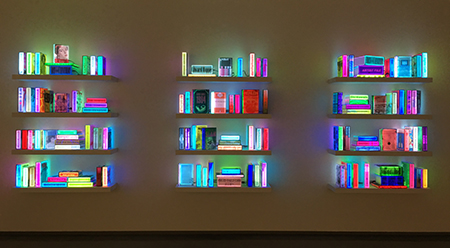 An exhibition that brings together 18 artists from Australia and Korea whose works encourage us to ask what it means to be human today, and what it might mean in the future, the Museum of Contemporary Art Australia (MCA) presents New Romance: art and the posthuman currently on display until 4 September 2016.
An exhibition that brings together 18 artists from Australia and Korea whose works encourage us to ask what it means to be human today, and what it might mean in the future, the Museum of Contemporary Art Australia (MCA) presents New Romance: art and the posthuman currently on display until 4 September 2016.
Drawing inspiration from science fiction, robotics, biotechnology, consumer products and social media, the artists offer experiences that raise questions around the idea of the posthuman; a concept that signals new understandings of humanity and a breakdown of boundaries between what we think of as natural and artificial.
Artists featured in the exhibition include Rebecca Baumann, Ian Burns, Hayden Fowler, Siyon Jin, Airan Kang, Sanghyun Lee, Soyo Lee, Wade Marynowsky, Moon Kyungwon & Jeon Joonho, Patricia Piccinini & Peter Hennessey, Kibong Rhee, Justin Shoulder, Giselle Stanborough, Stelarc & Nina Sellars and Wonbin Yang.
“New Romance: art and the posthuman marks the second collaboration between the Museum of Contemporary Art Australia and National Museum of Modern and Contemporary Art, Korea,” says MCA Director, Elizabeth Ann Macgregor OBE. “The exhibition signals the commitment of both institutions to supporting the work of contemporary artists and providing opportunities for audiences to discover new work.”
Curated by Anna Davis (MCA) and Houngcheol Choi (MMCA) the exhibition title takes inspiration from William Gibson’s science-fiction novel Neuromancer (1984). The cyberpunk work, which both celebrates and critiques technology, was originally mistranslated in Korea as ‘New Romance’. This lead to confusion and buyers originally thought it was a romance novel.
The artists in New Romance reflect on issues such as hybridisation, hyper-consumerism and alternative futures. Wonbin Yang creates an ecosystem of insect-like robots that the artist imagines could thrive in a city of the future; Patricia Piccinini and Peter Hennessey explore ideas of secret societies, parallel worlds, genetic modification, evolution and mutation; and Soyo Lee explores the history of a hybrid plant called the hibotan or moon cactus with installations, research materials and cactus grafting workshops.
Situated on the MCA forecourt, Hayden Fowler’s Dark Ecology (2016) considers how our relationship with the natural world is changing and the threat of ecological catastrophe. Artists Moon Kyungwon & Jeon Joonho ask questions about a future where ‘major climate change endangers human survival’ in EL FIN DEL MUNDO (2012).
Artist and engineer Ian Burns has reconfigured and reimagined consumer technologies that now define many human activities – the digital clock and humble desk fan. Rebecca Baumann’s kinetic sculptural installation made from 15 electromagnetic flip-dot signs are programmed to constantly shift fields of colour and create a flickering sound.
Airan Kang’s ongoing Digital Book Project explores the book as a symbol of human knowledge and its significance as a portal for information both as a physical object and in virtual space. In two Korean paintings from the Joseon era (1392–1897), Sanghyun Lee digitally manipulates the landscape to include layers of history and fiction. In addition, Lee has inserted internet game characters, Barbie dolls, K-Pop stars and luxury fashion brand logos.
To consider love in the digital age, Giselle Stanborough is an artist-turned-entrepreneur. Stanborough’s multi-platform work is based around a fictional match-making service. It includes interventions in the MCA’s online platforms, a product launch and a series of ‘TED talk’ style lectures given throughout the exhibition.
In the MCA entrance foyer, Moonwalker (2016) by Wade Marynowsky is a robotic sculpture suspended from the ceiling. The sculpture recalls Michael Jackson’s famous 1980s dance move and the first moon landing mission by Neil Armstrong and Buzz Aldrin.
Blender is a collaborative artwork by Stelarc & Nina Sellars. It combines sterilised bodily material that is surgically extracted via liposuction from the two artists inside a sealed, air-powered machine. The machine is designed to metaphorically represent a human body.
“Several of the artists take on the role of inventor or even mad scientist; experimenting with living organisms, building strange machines and constructing artificial worlds,” says MCA Curator, Anna Davis. “Some investigate how our emotions are triggered when interacting with objects, while others try to see the world from a nonhuman perspective.”
“Raising more questions than answers, the curious and inventive works in New Romance: art and the posthuman make us wonder what the future may hold.”
New Romance: art and the posthuman
Museum of Contemporary Art Australia, 140 George Street, The Rocks (Sydney)
Exhibition continues to 4 September 2016
Free admission
For more information, visit: www.mca.com.au for details.
Image: Airan Kang, Digital Book Project, 2016, installation view, New Romance: art and the posthuman, Museum of Contemporary Art Australia. LED lights, resin, 107 x custom, electronic books – photo by Rohan Shearn ©
